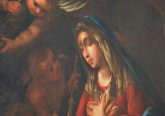Book Review: The Mary Pages

In an age that questions goodness, scorns chastity and denigrates motherhood, one might wonder how the Virgin Mary, the quiet heroine of the Gospels, could catch the attention of the modern feminist. In The Mary Pages, Sally Read recounts how the Blessed Virgin did exactly that. The Mary Pages reveals the compelling story of a personal conversion. Read’s road is a way of Beauty, wending from a London hospital to the Midwestern plains, to the mountains of Sardinia. The signposts along the road are various images of Mary, all of which reveal the power of the Blessed Virgin to inspire and to heal.
The Mary Pages opens with an invitation to look deeply into Filippo Lippi’s Renaissance masterpiece, The Madonna, Child and Two Angels, discovered in her grandmother’s house. At first, Read confined Lippi’s Madonna with her downcast eyes and silent adoration of her son, to a box under her bed, where it lay dormant during her raucous relationships of younger years. There is an interesting parallel in how the scandalous relationship between Lippi, a Carmelite priest, and his muse Lucretia Buti, a Dominican sister, produced a work of such contemplative loveliness, and how Read’s chaotic love life eventually drew her to the silence of Our Lady.
Read’s journey continues with an acheiropoieton—an image not made by human hands—when she encounters the Madonna of Guadalupe, as she begins to reject society’s objectification of the female body. Her road leads inexorably to Rome and Michelangelo’s Mary of the Pietà, as the author experiences motherhood. Throughout the book, Mary speaks in many voices, addressing numerous challenges and fears. Sally Read’s courageous intimacy allows the reader to see how these depictions of Mary penetrated her soul and wrought her conversion.
For this art historian, Read’s peregrinations to museums and chapels, where she perceives an ever-increasing call to faith, virtue and conversion, resonate deeply. The Mary Pages, however, is intended for anyone who has been deceived by what Pope Benedict XVI called “illusory beauty,” which, while dazzling, imprisons human beings in their own desires. Instead of lifting up the soul, the false shimmer of facile relationships easily convinces people that beauty is tawdry and love is superficial. The antidote to this spiritual stagnation is authentic beauty, exemplified by Mary, without stain of sin. Read once considered Mary “the embodiment of powerlessness.” But as life wears on, the Blessed Virgin becomes her companion in love, motherhood, loss and change.
What sets Read apart is her honesty, her ability to describe her choices without excuses, and her love for the beauty of words. The Mary Pages shifts gently from narrative to dialogue, from a few lines of verse to dramatic prose. She beckons the reader in myriad forms—solemn, ethereal, joyous, earthy—to a celebration of the woman whose soul magnifies the Lord.
The Mary Pages is an elegant read, meant to be savored, like art. Reading this evocative text, one imagines the Mary of Cana watching over the women of the world, ready to fly to her Son to tell Him that so many of them “have no wine” and to exhort them through gaze, gesture and inspiration: “Do whatever he tells you.”
Elizabeth Lev is a Rome-based art historian. She is the author of several books, including How Catholic Art Saved the Faith and The Silent Knight: A History of St. Joseph as Depicted in Art.
This article appeared in the April 2025 edition of The Catholic Telegraph Magazine. For your complimentary subscription, click here.














